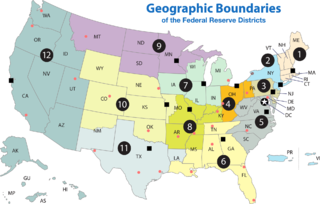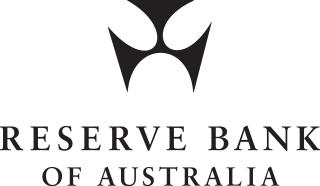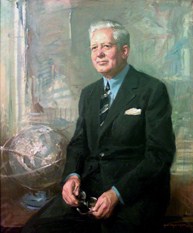
The Bank for International Settlements (BIS) is an international financial institution owned by central banks which "fosters international monetary and financial cooperation and serves as a bank for central banks". The BIS carries out its work through its meetings, programmes and through the Basel Process – hosting international groups pursuing global financial stability and facilitating their interaction. It also provides banking services, but only to central banks and other international organizations. It is based in Basel, Switzerland, with representative offices in Hong Kong and Mexico City.

Monetary policy concerns the actions of a central bank or other regulatory authorities that determine the size and rate of growth of the money supply. For example, in the United States, the Federal Reserve is in charge of monetary policy, and implements it primarily by performing operations that influence short-term interest rates.

A Federal Reserve Bank is a regional bank of the Federal Reserve System, the central banking system of the United States. There are twelve in total, one for each of the twelve Federal Reserve Districts that were created by the Federal Reserve Act of 1913. The banks are jointly responsible for implementing the monetary policy set forth by the Federal Open Market Committee, and are divided as follows:

The Reserve Bank of Australia (RBA) is the country's central bank and banknote issuing authority. It has had that role since 14 January 1960, when the Reserve Bank Act 1959 removed the central banking functions from the Commonwealth Bank.

The Emergency Banking Act, Public Law 1, 48 Stat. 1, was an act passed by the United States Congress in March 1933 in an attempt to stabilize the banking system. Beginning on February 14, 1933, Michigan, an industrial state which had been hit particularly hard by the Great Depression in the United States, declared an eight-day bank holiday. Fears of other bank closures spread from state to state as people rushed to withdraw their deposits while they still could do so. Within weeks, all other states held their own bank holidays in an attempt to stem the bank runs. Following his inauguration on March 4, 1933, President Franklin Roosevelt set out to rebuild confidence in the nation's banking system. On March 6 he declared a four-day national banking holiday that kept all banks shut until Congress could act. A draft law, prepared by the Treasury staff during Herbert Hoover's administration, was passed on March 9, 1933. The new law allowed the twelve Federal Reserve Banks to issue additional currency on good assets so that banks that reopened would be able to meet every legitimate call.
The Federal Open Market Committee (FOMC), a committee within the Federal Reserve System, is charged under United States law with overseeing the nation's open market operations. This Federal Reserve committee makes key decisions about interest rates and the growth of the United States money supply.

William McChesney Martin Jr. was the ninth and longest-serving Chairman of the United States Federal Reserve Bank, serving from April 2, 1951, to January 31, 1970, under five presidents. Martin, who once considered becoming a Presbyterian minister, was described by a Washington journalist as "the happy Puritan".

Lauchlin Bernard Currie worked as White House economic adviser to President Franklin Roosevelt during World War II (1939–45). From 1949-53, he directed a major World Bank mission to Colombia and related studies. Information from the Venona project, a counter-intelligence program undertaken by agencies of the United State government, references him in nine partially decrypted cables sent by agents of the Soviet Union. He became a Colombian citizen after the United States refused to renew his passport in 1954 due to doubts of his loyalty to the United States engendered by testimony of former Communist agents and information in the Venona decrypts.

David Matthew Kennedy was an American politician and businessman. He served as the 60th U.S. Secretary of the Treasury and later as the 8th U.S. Ambassador to NATO, both under U.S. President Richard Nixon. He was Chief Executive and Chairman of the Board of Continental Illinois during the 1950s and 1960s.

The United States Gold Reserve Act of January 30, 1934 required that all gold and gold certificates held by the Federal Reserve be surrendered and vested in the sole title of the United States Department of the Treasury.

Eugene Robert Black I was the Chairman of the Federal Reserve from May 9, 1933 to August 15, 1934.

The Marriner S. Eccles Federal Reserve Board Building houses the main offices of the Board of Governors of the Federal Reserve System. It is located at 20th Street and Constitution Avenue, N.W., in Washington, D.C. The building, designed in the stripped classicism style, was designed by Paul Philippe Cret and completed in 1937. President Franklin Delano Roosevelt dedicated the building on October 20, 1937.

The Federal Reserve Bank of New York is one of the 12 Federal Reserve Banks of the United States. It is located at 33 Liberty Street, New York, New York. It is responsible for the Second District of the Federal Reserve System, which encompasses New York State, the 12 northern counties of New Jersey, Fairfield County in Connecticut, Puerto Rico, and the U.S. Virgin Islands. Working within the Federal Reserve System, the Federal Reserve Bank of New York implements monetary policy, supervises and regulates financial institutions and helps maintain the nation's payment systems.

David Eccles was an American businessman and industrialist who founded many businesses throughout the western United States and became Utah's first multimillionaire.
Modern Monetary Theory or Modern Money Theory (MMT) is a heterodox macroeconomic theory that describes currency as a public monopoly for a government and unemployment as the evidence that a currency monopolist is restricting the supply of the financial assets needed to pay taxes and satisfy savings desires. MMT is seen as an evolution of chartalism and is sometimes referred to as neo-chartalism.

Spencer Fox Eccles is a prominent financier and philanthropist in Salt Lake City, Utah and chairman emeritus of the Intermountain Region of Wells Fargo Corporation. From 1982 to 2000 he was chairman and chief executive officer of First Security Corporation of Salt Lake City, which was, until its sale to Wells Fargo in 2000, the largest banking organization in the Mountain West measured by assets, deposits and market capitalization.

This article is about the history of the United States Federal Reserve System from its creation to the present.

Randal Keith Quarles is an American private equity investor and government official who has served as a member and vice chair for supervision of the Federal Reserve Board of Governors since October 2017. Previously he was founder and head of The Cynosure Group, a private investment firm, and a former partner of The Carlyle Group, one of the world's largest private equity firms. From August 2001 until October 2006, he held several financial policy posts in the George W. Bush administration, ultimately serving as Under Secretary of the Treasury for Domestic Finance.
Pushing on a string is a figure of speech for influence that is more effective in moving things in one direction than another – you can pull, but not push.

The Banking Act of 1935 passed on August 19, 1935 and was signed into law by the president, Franklin D. Roosevelt, on August 23. The Act changed the structure and power distribution in the Federal Reserve System that began with the Banking Act of 1933. The Act contained three titles.



























